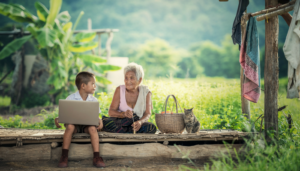 Do you want to make sustainable solutions part of your daily life? Good news! When it comes to the way you buy and sell, you can.
Do you want to make sustainable solutions part of your daily life? Good news! When it comes to the way you buy and sell, you can.
A big part of the plan to achieve the Global Goals – otherwise known as the Sustainable Development Goals (SDGs) – lies in changing the way you do business. Even if you don’t own a business, as a customer, you can be part of the solution.
While business is about making a profit, entrepreneurs and shoppers alike are quickly realizing that operations can go beyond dollars and cents. In following a Triple Bottom Line (TBL) framework, businesses can empower people, help the environment, and make money while doing it. By looking at sustainability from a social, environmental, and financial point of view, many opportunities and solutions for improvement present themselves.
Global Goal 12 – Ensure Sustainable Consumption and Production Patterns
This specific goal really reinforces the importance of doing business differently. It touches upon matters such as efficient use of natural resources, better waste management practices, and leveraging technology for advancement.
It also brings to light the importance of re-framing common economic practices such as subsidies and favorable tax advantages to sectors that are causing harm to the global community and the environment. Imagine a world where businesses that are good for the environment receive tax breaks and funding.
I’ve often drawn a direct line between sustainability and resource management. There is no goal that highlights this point better. You are in control of the way you consume. Yes, you do need to shop and buy things. However, you can make daily choices to ensure that the companies you support, and the products you buy, are empowering people, not exploiting them.
Fair trade is a great example of a movement that does just that. It serves as inspiration for individual customers to purchase with purpose. It also serves as empowerment to many social entrepreneurs out there looking to do things differently. Have you noticed stores now carry a larger selection of fair trade and organic products? That’s because more and more customers are requesting them.
Leading Role
While all countries will be involved in the shift from economic exploitation to economic empowerment, developed nations play the leading role. Because the average income level per capita of developed nations is higher, their citizens have more buying power for consumables. Also, developed nations have long looked to industries in developing nations to produce consumer goods at lower costs.
Though the history of production has been unfavorable for many workers across the globe, awareness and advocacy has brought forth the need to adjust the production line to ensure that work environments are safer, and human rights are respected no matter where someone ranks in a company.
Awareness about the impact on the environment through exploitative production has also led to customers thinking twice before purchasing a product that is destructive to the Earth. It’s become increasingly apparent that purchasing built to last, quality products is the most sustainable option for customers and businesses.
Vote for Change
When purchasing built to last, eco-friendly, ethical products, you are choosing to invest in items that are inspired by respect for people and the planet. You are investing in local tradition and culture. These products cost a little extra in the moment, but when things are built to last, they work out to be cheaper in the long run.
And from the profit point of view, just look towards a company like Patagonia, and you’ll see the success that accompanies doing business the sustainable way.
Making the Investment
In order to achieve the Global Goals, many are looking to private industry to make the investment. That means businesses and customers need to see the big picture: the interconnected nature of sustainability. For a business to be sustainable, attention must be paid to financial sustainability, environmental sustainability, and social sustainability. Not one or the other, but instead all three.
Inevitably it will take time to balance the equation, to adjust the variables that lend to each category. There will be trial and error, however if the ultimate goal is sustainable development, then business as usual isn’t going to cut it.
What’s your favorite sustainable product or business? I’d love to hear from you! Connect by leaving a comment below or joining the conversation on Twitter.



